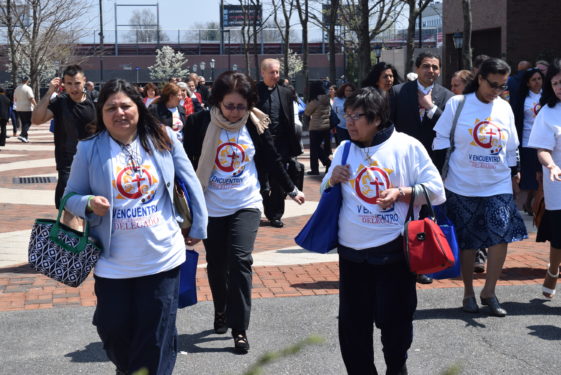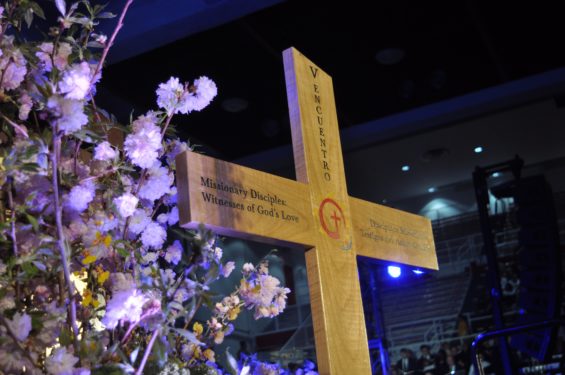
By Christopher White and Ines San Martin
NEW YORK / ROME – When St. Pope John Paul II traveled to Cuba in January 1998, becoming the first pontiff to visit the island nation, Brooklyn’s Auxiliary Bishop Octavio Cisneros recalls, “the whole world went with John Paul.”
While that visit would serve as a reset for Vatican-Cuba relations, the Cuba native says that, unfortunately, despite the great anticipation for the meeting between the pope and the Communist leader, it was quickly overshadowed by breaking news in the United States of then-President Bill Clinton’s marital affair and potential impeachment.
Bishop Cisneros, who has been one of the leading bishops planning this week’s V Encuentro – the national gathering that will serve as the capstone of 4-year process designed to discern the response of the U.S. Church to its Hispanic and Latino presence – is anxious that in a similar way, this past summer’s continual revelations of clerical sex abuse scandals could eclipse the Encuentro.
While Bishop Cisneros believes it’s imperative that the Encuentro not ignore the painful reality of the scourge of sex abuse, he also believes that this week’s gathering has the potential to serve as a bright, hopeful light during an otherwise bleak time for Catholics.
A Church Where Everyone Is Welcome
This week’s Texas gathering will bring together some 3,000 Catholics to conclude a four-year nationwide process of Hispanic/Latino missionary activity, consultation, leadership and pastoral discernment that took place in parishes, dioceses and episcopal regions in the United States.
As Archbishop Gustavo García-Siller of San Antonio, Texas, told The Tablet nearly two years ago, when those leading the process visited Rome where Pope Francis gave his blessing, “the hope is that the consultation will produce missionary disciples in the Catholic Church in the U.S.”
The V Encuentro taking place Sept. 20-23 is part of a tradition that began in 1972.
According to organizers of the Encuentro, it allowed the Hispanic Catholic community in the United States to “come out of the shadows and to express our needs, aspirations, and contributions as baptized persons livening in the Church in the United States.”
The second edition of the meeting took place in 1977, and it allowed Hispanic Catholics to celebrate “everything we have in common, our faith, culture and language in the midst of our diverse countries of origin, and we identified ourselves as a Pueblo de Dios en Marcha, (“People of God Walking”) said Spain-born Maria H. Sedano, Department Director of the Ministry Formation Institute in the Diocese of San Bernardino.
Sedano took part in that Encuentro and the ones that followed.
“I was a young adult, working in the Los Angeles Religious Education Office at the time, and as many of my counterparts, in the church and in the country, I was experiencing a great difficulty being accepted simply because I am Hispanic and do not speak fluently in English,” she told The Tablet.
She then attended the third and fourth Encuentros that took place in 1985 and 2000 but decided not to attend the Fort Worth gathering, instead leaving her place for “someone younger who can continue the work of implementing the results of the V Encuentro.”
Though it’s been almost five decades since that first Encuentro, according to Sedano, who’s been in ministry her entire adult life, many of the needs of the Hispanic community are the same as they were way back when: serving migrants, education, leadership development, access to higher education, catechesis, youth, family.
If anything, she said, “the needs have not changed; they are more defined and articulated now.”
There are 28 areas of need identified for the V Encuentro. Which one should be a priority, perhaps, is in the eye of the beholder, influenced by a person’s place in society and in the Church.
Yet for Sedano, the priorities are clear: Education and leadership development, particularly in second and third generation young adults.
“We concentrate on the recent arrivals and forget the Hispanic-Americans, who can serve as bridges among the cultures,” she said.
According to the official Encuentro timeline, the 1985 gathering allowed the Catholic Hispanic community in the United States to raise its voice to articulate a clear direction of the Church’s response Hispanic presence and our response as Church.
Related: Encuentro: A New Era for US Church
It was then that the 1987 National Plan for Hispanic Ministry was envisioned, presenting a model of a Church that “is evangelizing, communal, and missionary.”
The following edition was opened to “all of the cultures and races that make up the Church in the United States,” with a vision of a Church were everybody is welcome that emerges from the Hispanic identity, “like a community of mestizos and mulattos that are pilgrims in this land and called to be wings of solidarity with the many faces in God’s house.”
Common Denominator Commitments
Like Sedano, Boston College theologian Hosffman Ospino, who has been intensely involved in the V Encuentro process, believes that while many of the needs of Hispanic Catholics remain the same, that the V Encuentro process has helped to crystalize the immediate priorities.

For Ospino, the “three common denominator commitments” that he believes everyone shares – and hopes that the V Encuentro will produce outcomes – is greater attention to young Hispanics, to families, and the need for more Hispanic leadership.
To his last point, he wants to make one thing clear: “There are plenty of Latino leaders. There are leaders who are willing, capable, and ready to engage in ministry and in service of the Church,” he told The Tablet.
“What they’re saying is they need formation and they need spaces to exercise leadership. They’re begging for those spaces. We need to create those spaces for them in Catholic schools, university, dioceses, and the Church needs to be investing in them,” he insisted.
The Texas gathering will be the culmination of a work that began in January of 2017, with a series of five sessions at parish level. Then five gatherings took place at a diocesan level, with each step leading people to mission and concluding with a diocesan celebration. Then a similar process was repeated in each of the 14 regions of the U.S. Conference of Catholic Bishops (USCCB), all of which leads to Texas where some 3,000 delegates from nearly every diocese of the United States will participate.
In recent years, delegates and participants in the V Encuentro have been engaged in a process of listening to Hispanic Catholics where they are: parishes, schools, prisons, hospitals and even at the U.S. Mexico border.
According to Archbishop García-Siller, there will be a two-year follow-up process to guide the plans of the U.S. bishops, actually modifying structure.
Once upon a time, the Latino presence in the U.S. was reduced to four or five dioceses, such as Los Angeles, Florida, Chicago or San Antonio. Today, however, there are Hispanics in all the states, including Alaska.
A consultation report released in May by the V Encuentro shows 55 percent of Catholics younger than 14 are Hispanic, and that there are 4,473 parishes with services directed to Hispanics – most frequently with one or more Masses in Spanish.
On an average weekend, about 2.7 million people attend the 7,900 weekly, monthly, or bi-monthly Masses in Spanish in the U.S. – about 340 people per Mass, yet the percentage of Hispanic priests to serve this community is below the national average.
According to the survey, in the U.S. today there are about 2,000 Catholics for every priest; 6,000 immigrant Hispanic Catholics for every immigrant Hispanic priest; and 23,000 U.S.-born Hispanic Catholics for every U.S.-born Hispanic priest.
Ospino told The Tablet that what these numbers – and the V Encuentro process – reveal is a Church that is “begging to be engaged, recognized, and affirmed.”
“We know the demographics, we know the large numbers of Latinos at all levels, young adults, children, and so forth,” he continued.
“But still, many of our Catholic structures nationwide manage to live as Latinos that are either visible or do not exist,” he said. “That’s the big surprise, just to see the inability to recognize the gifts we have and the opportunity for the Catholic Church to think in new ways about how we are to build society and build the Church in the 21st century.”
Even so, Ospino said that in recent years he’s been grateful for the number of Church leaders who have used the Encuentro process to effectively admit what they don’t know.
“I have also been pleased with the response we’ve had from bishops and diocesan officers to the Encuentro,” he said. “People want to know more, they are interested, and they’re willing to learn. That’s a good start. It indicates a level of humility that many pastoral leaders have and many others pastoral leaders can cultivate moving forward.”
Bishop Cisneros concurred, telling The Tablet that the diocesan and regional Encuentros served as a time where previously unengaged folks became interested in becoming involved.
“What I’ve been really impressed by in the process of the Encuentro is the desire for people to participate in the life of the Church, the desire of all the parochial ministries, and many who have not been involved in parochial ministries and any apostolate, but now say, ‘I want to participate in this,’” he said.
Fresh Air for the Church in the United States
Ultimately, according to organizers of the V Encuentro, the process of the past few years has helped to solidify a “Latino consciousness” among Hispanic Catholics that has produced a new sense of confidence about their place and contributions within the U.S. Church.
“It’s been exciting to see farm workers, or people working in factories, people working in offices, people working in dioceses, they speak a common language that ‘we are Catholics in the United States.’ And that’s fresh air for the Church in the United States,” Ospino told The Tablet.
Even so, he is warning that measuring the success of the V Encuentro is not something that can be done in the short term or through immediate measurables, but rather, a long-term rethinking of what it means to be Catholic and to practice Catholicism in the United States.
Success, according to Ospino, will be measured by the type of transformation that “all the Church’s sectors and organizations, begin to see the Hispanic community as the Church in this country.”
“The way of measuring the success of the V Encuentro is when the Catholic Church in the United States begins to view Hispanic Catholics not as an addendum, not as a separate ministry or a problem to be solved, but ‘this is who we are’ and ‘we are Church that is diverse.’”
Alejandro Aguilera-Titus, the national coordinator for V Encuentro, concurred, telling The Tablet that success will not just be about recognizing the emerging majority of the Hispanic Catholic population of the U.S. Church, but welcoming the ways in which it can lead the Church as a whole.
“This is a ‘Hispanic Latino moment’ as Archbishop Jose Gomez of Los Angeles refers to the Encuentro,” said Aguilera-Titus.
“I say it’s not only a moment, but it’s a movement,” he continued. “And at its core, that movement has Hispanic Latino Catholics reaching out to the Church in the United States with their ‘yes.’”
“The V Encuentro process is not only to see what the Church can do for the Hispanic people but also how Hispanic Latinos can serve as provide leadership to the whole Church.”
